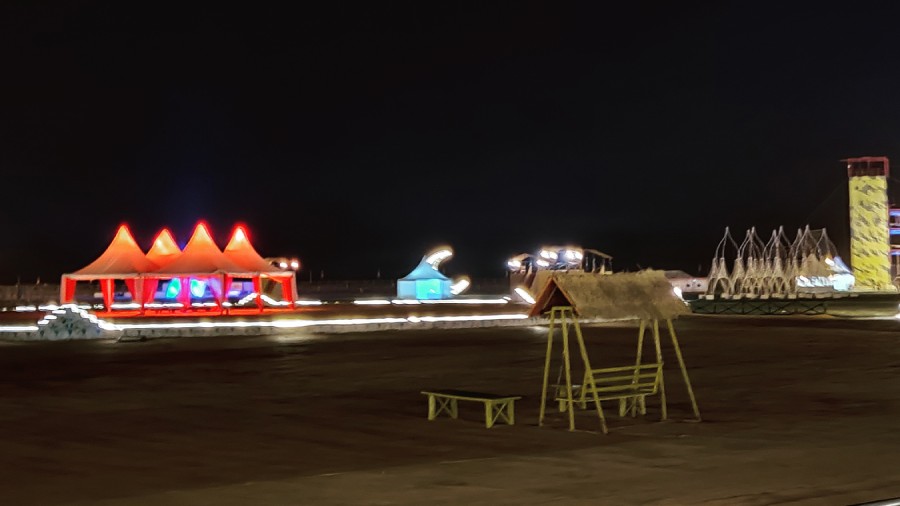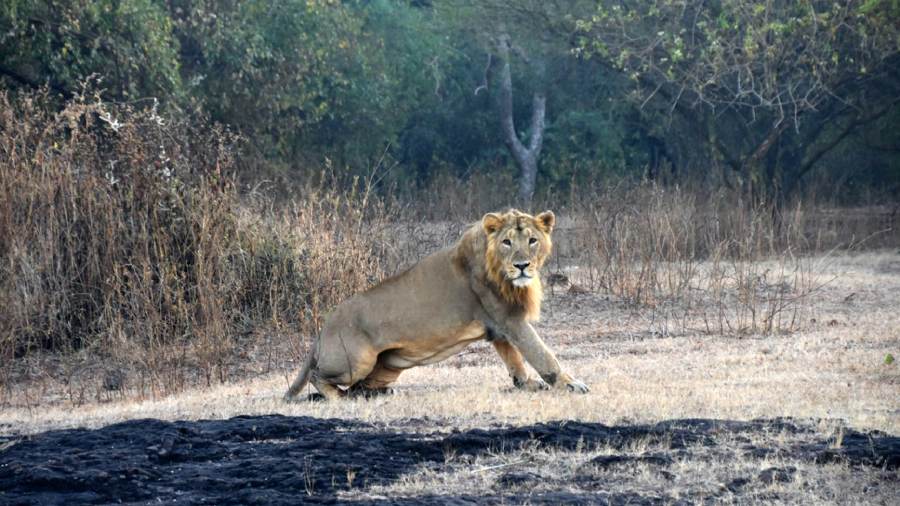If you do not travel, you will never know. I am sure many of us have felt this numerous times when we travel. These were my exact thoughts when I was enjoying a very athletic dance performance by the Siddis on our hotel lawns in Sasangir, a village near Gir National Park.
I had no clue that the descendants of an African tribe live in one part of India. They are known as Siddis. According to the most recent census of 2011, the current population of the Siddi community in Gujarat is approximately 20,000 to 30,000 individuals. They are the descendants of labourers who were brought by Gujarati traders in Zanzibar and other African states from the late 18th century to the early 19th century. Those familiar with Bengali historical novels would be familiar with the term Habshi.
Siddis and Habshis are used interchangeably and are the same tribe who descended from the Bantu people of Southeast Africa. The term Habshi derives from the Arabic word Habashi, which again was derived from the Persian for Abyssinian. In Bengali literature, Habshis were employed as bodyguards for kings and queens. This depiction is based in reality as in the past some were engaged in local kings’ armies. Some even gathered political influence over time. One of them ruled over parts of Bengal in the 15th century.
After the East India Company imposed the Permanent Settlement in 1793 – first in Bengal and then the rest of India — all rulers lost their right to maintain an army, resulting in many Africans losing their jobs. These Africans then began moving to the margins, as their assimilation into the greater society never happened as they looked “too African” in body and belief.
Marginalised in every sense, Siddis in Gujarat came to live in small pockets near Bharuch and Jamnagar. Their presence is somewhat noticeable in 18 villages around Gir forest now. The Siddi groups perform a particular form of dance which they call goma, a word that has its origin in the Swahili word ngoma, which means ‘drum’. They sing to the Siddi saint Baba Gor while dancing.
The most significant African retention is the malunga, a braced musical bow, which is found in many African communities. For us, the curious part of watching them dance was the unexpected surprise and the realisation how little we know about our own, hugely diverse country.

The descendants of an African tribe live in one part of India. They are known as Siddis.... Siddis and Habshis are used interchangeably and are the same tribe who descended from the Bantu peoples of Southeast Africa
Kathiawadi palate
For a strictly non-vegetarian, naturalised Bengali, getting accustomed to the overwhelmingly vegetarian cuisine of Gujarat can be a challenge. However, the Kathiawadi cuisine, which is the regional cuisine in the area we travelled, was a revelation.
Kathiawad comprises Saurashtra region with major cities such as Porbandar, Jamnagar, Bhavnagar, Rajkot and Junagadh. It is one of the oldest cuisines of India that is gaining popularity for wholesome, fresh meal made with simple ingredients that are readily available locally.
The rich Gujarati cuisine in general consists of four regional cuisines — Kathiawadi, Kutchi, Surti and Amdavadi. Each of these regions has a distinctive flavour associated with its local preparation that brings their own uniqueness to the Gujarati cuisine. Despite having a coastline with abundance of seafood availability, Gujarat is primarily a vegetarian state.
Many areas in Kathiawad have dry and harsh weather, which results in low vegetation zone. Hence most varieties of dishes are made with potato, millets, tomatoes and brinjal. Farsan (a collection of snacks) is a predominant food of this cuisine that has become a part of Gujarati tradition. This cuisine is well known for its spicy food made with simple ingredients.
What differentiates Kathiawadi food from the rest of Gujarat is the lack of sweetness in the vegetable preparations. The biggest difference is that while most Gujaratis use spices such as hing, chilli, turmeric and coriander powder for everyday preparations, Kathiawadis add onion and garlic. However, it is served with a side of jaggery mixed with ghee. Some of the must-try traditional delicacies are lasaniya bataka, ringan no olo, and sev tameta nu shaak.
Spotting the Asiatic lion
We travelled to Rajkot from Kolkata and from there made our way to Gir National Park after a three-and-a-half-hour drive. The safaris were booked by our hotel and we were fortunate to have a fantastic guide who enabled us to see about 17 lions and four cubs. Gir is now the only place where you can watch Asiatic lions in their natural habitat and was designated as a sanctuary for lion conservation in 1965. Interestingly, authorities of Gir and Gujarat state have resisted moves to establish sanctuaries for lions in other parts of India, as it will mean that Gir will lose its unique status.
Asian lions once used to range from Turkey, across Asia, to eastern India, but the rise of firearms across the world meant that they were hunted to near-extinction for sport. Asian lions are slightly smaller than African lions. Unlike African lions, the males do not tend to live with the females of their pride unless they are mating or have a large kill.
The male Asiatic lion has a relatively short, sparse and darker mane compared to the fuller mane of the African lion. As a result, the male Asiatic lion’s ears tend to remain visible at all times. The most distinguishing characteristic of the Asiatic lion is the longitudinal fold of skin that runs along its belly. This is absent in African lions.
The place where we stayed was close to the reserve forest. One of the most interesting features of this really soothing resort was the unique wake-up call in the mornings. A lone flute player would go around the property, playing beautiful tunes. It was really magical to be woken up by hundreds of bird call and sound of a flute in the morning.
Our itinerary included two other places in Rann of Kutch, which is a paradise for bird watching and Dhordo, the place where the famed Rann Utsav is held. Travelling to these three different places meant a fair amount of travel by car, but as the road conditions are good, it is not taxing at all.
Situated about 130km from Ahmedabad, the Rann of Kutch is a seasonal salt marsh located in the Thar desert in Gujarat. Rann in Hindi means desert. Centuries ago, the Rann of Kutch was part of the sea until an earthquake turned the exposed seabed into a sprawling desert.
Today, it is a vast expanse of arid land, devoid of habitation, stretching out to the Arabian Sea, which is just 10km away. The nothingness for miles is stunning. It has small oasis of waterbodies and shrub forests doubling up as homes for pink flamingoes and wild asses.

The Rann of Kutch is a seasonal salt marsh located in the Thar desert in Gujarat
Rann of Kutch and its many wonders
The highlight for me, at the Rann of Kutch, was seeing the local people, called Agariyas, producing salt. Apparently three-fourth of India’s salt is manufactured here, through techniques which are remarkably primitive and harsh for the labourers. Here, families make homes from plastic sheets and bamboo poles, and work from September to April in scorching sun. It is arduous labour to produce salt here.
During the monsoon months, the Rann of Kutch is submerged in sea water. As the sea water finally begins to recede in September-October, the Agariyas move in and begin the elaborate process of salt farming. First, they dig wells to pump out highly saline groundwater from the lake of brine that lies about 40ft below the ground level.
To do this, they must manually move and roll the earth to create shallow, rectangular pans that collect the salt for slow evaporation under the hot desert sun. Ten times saltier than sea water, this lake of brine is what keeps the economy of the area afloat. The pumped-out brine is left in square-shaped salt pans where the natural process of evaporation works to leave behind white crystals of salt. Getting these pans ready for this process is tough work.

Dhordo is a village in the Kutch region that hosts the Rann Utsav. An entire mini city including 400 tents is built for this.
The farmers stamp and level the earth with their bare feet to ensure that the tightly packed soil doesn’t allow the brine to seep back. Some dry branches are thrown in, around which salt crystals form. Later, they rake these pans until large crystals of salt are left behind to be harvested by hand. Working every day under temperatures as high as 40 degrees centigrade, the Agariyas harvest 75 per cent of India’s total salt produce.
Approximately 200km east of the Rann is the Little Rann of Kutch, which houses the 4,953sq km Wild Ass Sanctuary. It is home to the only remaining population of the chestnut-coloured Indian wild ass (khur), as well as blue-bulls, blackbuck and chinkara.
In 2001, Rann of Kutch witnessed a devastating earthquake. It was after this earthquake that the government realised the tourism potential of the place. They decided to rebuild the desert region of Kutch by a celebration of the cultural and geographical distinctions of the region. In 2004, Rann Utsav was celebrated for the first time. During that time, the festival was celebrated only for three days surrounding the full moon night. Gradually the number of days kept on increasing and finally today, Rann Utsav is celebrated for four months starting from November and going on all the way to February.
Dhordo is a village in the Kutch region that hosts the Rann Utsav. An entire mini city including 400 tents is built. There are large areas for cultural activity, adventure sport and dining halls. Local artisans put up stalls to display their handicrafts. It essentially transports you to a unique place, where you eat, breathe and see the local culture. The highlight of the festival is the trip to see the sunset at the white desert. Amitabh Bachchan, in the advertisement for Gujarat Tourism, says, "Kutch nahi dekha to kuch nahi dekha". It is partly true. The sunset over vast flat white sands can be magical, but for the crowds.

There are various categories of accommodation (in tents) available at the festival venue. All meals and trips are included in the price. There are two- or three-night packages available, but the entire programme gets sold out much in advance. The Rann Utsav is a testament to Gujarati entrepreneurship and commitment to revitalise the area which was destroyed due to an earthquake. It is worth visiting, if not for anything else but to admire the logistics of the festival, where almost everything gets dismantled after the festival is over, to be built again the next year.
The other part of the trip which we enjoyed, despite being skeptical about it initially, was visiting the Wild Ass Sanctuary. Flamingoes over setting sun with wild asses grazing the barren land create some valuable opportunities for photographers. It is definitely worth a visit. Our trip to Gujarat was focused on wildlife viewing, birding and the Rann Utsav. We came back knowing a lot more not only about Gujarat but about the diversity of India.
Dr Jai Ranjan Ram is a senior consultant psychiatrist and co-founder of Mental Health Foundation (www.mhfkolkata.com). Find him on Facebook @Jai R Ram
